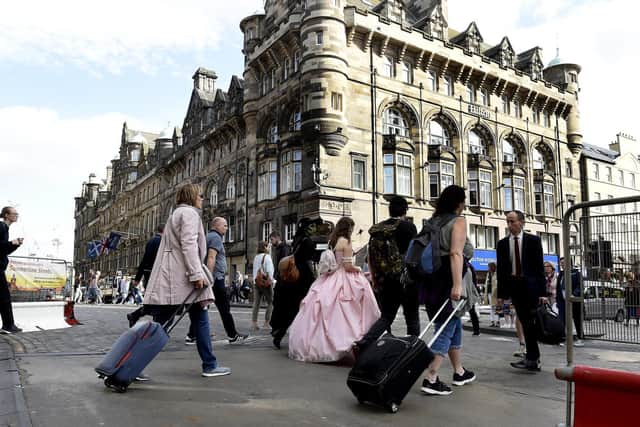Radical rethink on future of Edinburgh tourism will give residents more of a say amid growing concerns
and live on Freeview channel 276
A radical rethink on the future of tourism in Edinburgh will give its citizens more of a say in how the industry is managed and promoted around the world in the wake of growing concerns over the impact of "overtourism" on the Scottish capital, it was claimed today.
City leaders pledged to "put people, place and planet first" by spreading its footprint more across the city, making industry leaders more "accountable" to local residents and ensuring that spending from visitors is "retained within the local economy."
Advertisement
Hide AdAdvertisement
Hide AdTourism chiefs said the new 10-year strategy, which was instigated by the industry and the city council more than a year ago, is aimed at ensuring tourism is seen as “a benefit, not a burden” by taxpayers.


The blueprint for the decade - which has been published following a string of controversies about Edinburgh’s world-famous Christmas and Hogmanay celebrations - will see a significant shift in emphasis “from driving growth to managing growth.”
The tourists of the future will be asked to help reduce the environmental impact of their visit, there will be a new emphasis on promoting the use of local suppliers and selling Scottish-made products, and the whole sector will be tasked with properly “measuring and mitigating” its environmental impact for the first time.
Other pledges include ensuring that the city’s built heritage and natural environment is “cherished and cared for as a fundamental aspect of the city’s character, and that Edinburgh remains an authentic “living, working city.”
Advertisement
Hide AdAdvertisement
Hide AdThe 10-year vision is expected to lead to a shake-up of how the industry in Edinburgh is overseen and the creation of a new body which will tackle problems and challenges while “ensuring effective resident engagement.”


The new blueprint describes Edinburgh’s tourism industry, which currently supports 33,000 jobs, as “one of the biggest success stories,” with a 54 per cent increase in overseas visitors over the last decade and the number of domestic visitors up by almost a third.
However Edinburgh was named a global overtourism hotspot last year, alongside Amsterdam, Rome, Venice and Barcelona.
The blueprint also includes a pledge that Edinburgh will focus on ‘place-based reputation management” in future by providing both an “optimal living environment” for residents as well as a high-quality experience for visitors.
Advertisement
Hide AdAdvertisement
Hide AdUnder the rethink of the industry - which has been ordered amid growing tensions between community groups, heritage organisations, the city council, and industry bodies - a three-year action plan will be drawn up to reflect the new vision.


The new strategy states: “Long-term projections show that tourism demand in Edinburgh will increase. Our tourism supply is growing too - hotels are under construction; transport connections are improving, the festivals are increasingly popular and developments such as the St James Quarter and the waterfront will create new reasons to visit the city.
“Like its peers, the city has traditionally focussed on driving tourism growth, however in light of what we know about tourism in a growing city, it’s time to adapt our approach by working to make this growth work better for the city.
“It’s also time to recognise that some forms of tourism activity pose more challenges to the city than others, and that in the interests of all, there may be some difficult decisions to be made in the future.”
Advertisement
Hide AdAdvertisement
Hide AdCouncil leader Adam McVey said: “We have big ambitions for the future and we’re working with our partners to shift focus from promoting to better managing Edinburgh so we put people, place and planet first.
“Maintaining the status quo is not an option when it comes to tackling some of the city’s biggest challenges, be it congestion, pollution, population growth or tourism, which is why we’re doing things differently across the board.
“This 10-year plan is the blueprint for striking a much better balance between the needs of the city, visitors and residents. It’s about planning ahead, embracing the benefits of tourism while spreading this success around the city so that everyone can benefit.
“We have 35,000 local residents employed through the visitor economy and tourism is a hugely important part of Edinburgh’s success, however we all accept the need to better manage that success.
Advertisement
Hide AdAdvertisement
Hide Ad“Already, we’re close to becoming the first city in the UK to introduce a tourist tax – we’ve produced a comprehensive plan for a £2 a night transient visitor levy which will allow Edinburgh to directly benefit from visitor spend and reinvest funds back into the city– and news of a regulatory system for short term lets following our calls to the Scottish Government will provide another welcome shift.
“It’s been a decade since our last strategy and clearly the world has changed in many ways. This shift in policy reflects the new challenges our city faces.”
Donald Emslie, chair of the Edinburgh Tourism Action Group, the main voice of the industry in the city, said: “Edinburgh has long been recognised as an extremely successful, innovative and forward thinking exemplar of tourism development in the UK.
“The 2030 strategy reflects this, presenting a significant step change in the approach to tourism in the city that responds to the changes, challenges and opportunities that the 2020’s will bring.
Advertisement
Hide AdAdvertisement
Hide Ad“By focusing on making tourism work better for the city and the need for more effective, proactive management to mitigate the negative impacts that can be generated, I have no doubt that we can we can ensure that tourism is seen as a benefit, not a burden, going forward.
“Of course, the strategy is vital in terms of setting out the overall direction for the next 10 years, but it is only the starting point.
“Once it is finalised, the detailed action plan for the first three years can be developed and while that’s likely to require some bold and potentially difficult decisions to be made, it also presents exciting opportunities that will ensure that Edinburgh’s tourism sector continues to thrive as an essential part of the city’s economy.”